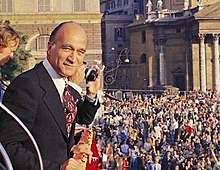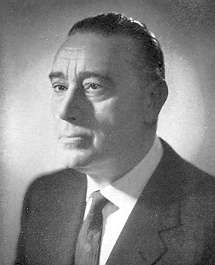Italian Social Movement
The Italian Social Movement (Italian: Movimento Sociale Italiano, MSI), renamed in 1972 Italian Social Movement – National Right (Italian: Movimento Sociale Italiano – Destra Nazionale, MSI–DN), was a neo-fascist[7][8][9] and national-conservative political party in Italy.
Italian Social Movement Movimento Sociale Italiano | |
|---|---|
 | |
| Abbreviation | MSI |
| Leaders | Giorgio Almirante Augusto De Marsanich Arturo Michelini Pino Rauti Gianfranco Fini |
| Founded | 26 December 1946 |
| Dissolved | 27 January 1995 |
| Merger of | Italian Movement of Social Unity Italian's Front[1] |
| Succeeded by | National Alliance (legal successor) Tricolour Flame (split) |
| Headquarters | Via della Scrofa 43, Rome (last) |
| Newspaper | Secolo d'Italia |
| Youth wing | Fronte della Gioventù (Youth Front) |
| Membership | 202,715 (1993) 240,063 (peak, 1963)[2] |
| Ideology | National conservatism Neo-fascism Italian nationalism |
| Political position | Right-wing[3] to far-right[4][5][6] |
| European affiliation | European Social Movement (1951–62) National Party of Europe (1962–66) |
| European Parliament group | Non-Inscrits (1979–84) European Right (1984–89) Non-Inscrits (1989–95) |
| Colours | Black |
Formed in 1946 by supporters of the former dictator Benito Mussolini, most of whom took part in the experience of the Italian Social Republic and the Republican Fascist Party, the MSI became the fourth largest party in Italy by the early 1960s. The party gave informal local and eventually national support to the Christian Democrats from the late 1940s and through the 1950s, sharing anti-communist ideologies. In the early 1960s, the party was pushed to the sidelines of Italian politics, and only gradually started to gain some political recognition in the 1980s.
There was internal competition between the party's moderate and radical factions. The radicals led the party in its formative years under Giorgio Almirante, while the moderates gained control in the 1950s and 1960s. Almirante's return as leader in 1969 was characterised by bigger-tent strategy. Finally, in 1987, the reins of the party were taken by Gianfranco Fini, under whom it was transformed into National Alliance (AN) in 1995. On that occasion a small minority, led by Pino Rauti, disagreed with the new course and formed Tricolour Flame instead.
Background
The MSI derived its name and ideals from the Italian Social Republic (RSI), established by Benito Mussolini in 1943 in the northern part of the Italian Peninsula behind Nazi German frontlines.[10] The dominating party of the republic, Mussolini's Republican Fascist Party (PFR), inspired the creation of the MSI.[11] The party was formed by former fascist leaders and veterans of the republic's fascist army,[12] and it has been regarded as the successor to both the PFR as well as the original National Fascist Party (PNF).[13] The MSI nevertheless tried to modernise and revise fascist doctrine into a more moderate and sophisticated direction.[14] It also drew from elements of the anti-communist and anti-system stance of the short-lived postwar populist Common Man's Front protest party, and many of its original backers would find a home in the MSI after its dissolution in 1949.[15]
History
Early years (1946–1954)
On 12 November 1946 was founded the Italian Movement of Social Unity (Movimento Italiano di Unità Sociale; MIUS) by Giorgio Almirante and a group of former fascist veterans of the Italian Social Republic (RSI),[16] a "violent, socialising, and revolutionary republican" variant of fascism that had operated as a Nazi puppet state in northern Italy between 1943 and 1945.[15] The MIUS was established to give a formal role to its representatives, who were supposed to attend a meeting of 26 December in the Arturo Michelini's office.
The Italian Social Movement was officially created on 26 December 1946 in Rome, absorbing smaller groups like the MIUS, the Fronte dell'italiano, the Fronte del Lavoro, the Unione Sindacale dei Ferrovieri Italiani, La Revolta Ideale and the Gruppo Reduci Indipendenti. Former RSI official Giorgio Almirante became the party's first leader.[17] The three initial main goals of the party were to revive Mussolini's fascism, attack the Italian democracy and fight communism.[18][19][20] However, due to the anti-fascist consensus embodied by the post-war Italian constitution and agreements with the Allied forces, advocating a return to fascism had to be done discreetly.[18][15] Although the MSI adapted itself into the constraints of the democratic environment, its manifest ideology was clearly antagonistic and antithetical to liberal democracy,[20] and it was consequently excluded from the Arco costituzionale, the circles of parties deemed legitimate to govern, as were Communists after 1947.[15]
The MSI won financial support from wealthy businessmen and landowners who feared a possible communist regime seizing power in Italy,[18] either coming from a domestic revolution or a takeover by Soviet forces. In the first general election of 1948, the neo-fascist party won seven deputies and one senator.[21] But the MSI soon witnessed growing internal conflicts between conservatives, who sought involvement in NATO and political alliances with Monarchists and Christian Democrats, and hardliners who wanted the party to turn into anti-American and anti-establishment platform.[18][22] Almirante was replaced as the leader of the party in 1950 due to his uncompromising anti-NATO position. His position taken by conservative Augusto De Marsanich, under whose leadership the party won some strong electoral gains.[23][18]
Arturo Michelini (1954–1969)
Four years later in 1954, De Marsanich was replaced by Arturo Michelini.[18] The conservative elements dominated the party in the 1950s and 1960s,[22] and it maintained a rather moderate course.[24] By the late 1950s, the MSI had become Italy's fourth largest party, and the Italian party system was unique in Europe in terms of having a continual and significant neo-fascist presence since the end of World War II.[18][24][25] Michelini established the strategy of inserimento (insertion) during his leadership of the party, which consisted in gaining acceptance through cooperation with other parties within the framework of liberal democracy.[26][15] Disgruntled by the MSI's focus on parliamentarism and their attempts to establish an image of democratic respectability, the radicals broke out to create several splinter groups. Pino Rauti and others left in 1956 to found Ordine Nuovo, while Stefano Delle Chiaie established the National Vanguard in 1960.[18][24]
In the wider context of the Cold War, anti-communism had replaced anti-fascism as the abiding principle of the Italian Republic,[15] and Christian Democrats started to accept political backing from the party (along with Monarchists and Liberals) to prop up their minority governments after the 1958 general election. Already in the late 1940s, the Christian Democrats, somewhat reluctantly, had discreetly accepted support from the MSI to keep the Communists out of the Roman city government.[27]
In March 1960, the MSI even became the sole backer of the Christian Democratic minority Tambroni Cabinet, which had enormous political implications.[28] As concerns grew over the party's expanding role in Italian politics, riots became commonplace between neo-fascist supporters and radical leftists.[18][24] Learning that the National Congress of the MSI was about to be held in Genoa in July 1960 to celebrate the accomplishment of the inserimento strategy, militant anti-fascist protests erupted on June 30 in the city. Those rallies spread to other Italian cities over the next fortnight, resulting in violent and sometimes lethal clashes with the police. The government consequently banned the congress from taking place, and eventually resigned on July 27.[28] This event marked the failed end of the inserimento strategy, and the beginning of the long party's decline.[28][29] Following the victory of a centre-left government in 1963, the Christian Democrats no longer needed the parliamentary support of the MSI, and the party was definitively forced back into "political ghetto". Its main objective in the following decades thus became to get back into the political game.[30][15] The demise of the strategy is also deemed conducive to the radicalization of the violent splinter groups like Ordine Nuovo.[15]
Giorgio Almirante (1969–1987)
Michelini remained the leader of the MSI until his death in 1969, when the party's first leader Almirante regained control. The latter attempted to revitalise the party by pursuing an aggressive policy against left-wing student uprisings,[18] since the 1968 student movement had been devastating for the party's youth organisation.[28]
Learning from Michelini's failed approach of inserimento, Almirante declared in his report to the party's central committee in 1969: "We stand before two different paths: an alternative to the system or an alternative within the system".[31] He introduced a double strategy of hard anti-systemic discourse combined with the creation of a broader "National Right" (Destra Nazionale) coalition in 1972.[29] He broadened the party in both conservative and radical directions, initiated a cooperation that eventually led to a merging with the Monarchist National Party, reintegrated Rauti and other radicals into the MSI, and attempted to attract conservative figures from the Christian Democrats and the Liberals.[22][30][15] The party grew strongly in the early 1970s, claiming 420,000 members in 1973.[22] Contesting the 1972 general election in a joint list with Monarchists,[22] the MSI almost doubled its support up to 8.7% of the votes, its highest score ever until 1994. It successfully capitalized on southern protests and an agenda of "law and order".[15]
However, the MSI supported violent actions of young people, the revolts in the Mezzogiorno, and MSI in contact with some sectors of terrorismo nero ("black [right-wing] terrorism"). Those connections, in apparent contraction to the respectability sought by the party, damaged its public reputation.[15] Support for the MSI consequently receded in the 1976 general election, and many conservatives pulled out from the party, leaving it with 279,000 members that year.[22] Frustrated in their aspiration to turn the MSI in a mainstream conservative party, moderates formed the National Democracy party in 1976, accusing Almirate of maintaining contacts with right-wing terrorism and of being unable to follow a concrete parliamentary strategy.[15] The new party, which took with it half the MSI parliamentary representation and nearly all of its public finance, was however dissolved in the aftermath of the next general election.[32]
During the late 1970s and early 1980s, a second wave of right-wing terrorism in Italy led to political radicalisation among some MSI members, and a part of them left the party to form new splinter groups.[22] A new wave of studies and "historicisation" of fascism, widely debated in the public media, participated in pacifying the political climate. The MSI's insistent denunciations of violence began to gain in credibility, and the party became less stigmatised in mainstream politics. After he became prime minister in 1983, Bettino Craxi of the Italian Socialist Party met with MSI leaders, and his office later issued a statement that expressed regret for the "ghettoisation" of the party. In 1984, high-level representatives of the Christian Democrats, the Liberals and the Democratic Socialists attended the party congress of the MSI for the first time. The next year, the party was granted a position on the board of directors of the RAI, the state radio and television network.[33][34]
Gianfranco Fini (1987–1995)
Gianfranco Fini took over the party leadership from Almirante in 1987, as his anointed successor and favoured candidate by the party's old guard. However, following Almirante's death the next year, Fini was left without his protector, he was gradually viewed as a weak leader, unable to turn around the decline and isolation of the party. Fini also adopted provocative initiatives against the internal opposition.[25][35][36]
In 1990 Pino Rauti briefly gained the leadership of the party from Fini, but his revolutionary, anti-capitalist and leftist (yet loyal fascist) approach further alienated the party's supporters. As a result, Fini regained the leadership in 1991.[25][37] Fini now sought to downplay the fascist origins of the MSI, further dividing the party into several factions. He transformed the MSI into the more moderate National Alliance (AN), going farther than Almirante's 1970s "National Right" strategy. Fini became to be viewed as a skilful political operator and he gained the support of the party majority.[18][22][38][39]
In the Tangentopoli scandals of the early 1990s, a pool of judges discovered a widespread system of corruption in all of the mainstream Italian parties, and many key politicians were brought on trial. The scandals were devastating for the involved parties and resulted in their dissolutions, and the so-called "First Republic" collapsed. The MSI was not affected by the scandals, for it had not been taken part in the Italian political life. Nevertheless, a radical transformation was required to break away from its fascist heritage.[40] At the same time, the end of the Cold War helped de-radicalising Italian politics. The corruption scandals also led the Italian political competition to become very personalised. In 1993, Fini and Alessandra Mussolini, the granddaughter of Benito Mussolini, surprisingly won unprecedented large support when running for mayor in Rome and Naples, respectively. Although they lost the elections, they each won about 45% of the vote.[41]
The AN project was launched in 1993, contested the 1994 general election, and in January 1995, the MSI was finally dissolved and replaced by AN.[42] Rauti and other radicals attempted to reconstitute the MSI as Tricolour Flame, but with only modest success. Fini in turn went on to lead AN to huge electoral gains, into the Pole of Good Government coalition with political newcomer Silvio Berlusconi and his Forza Italia party, and eventually into part of his governments.[18][43][44] The party's partication in the 1994 government met strong criticism from several European politicians,[45][46] but did not manifest itself in any diplomatic implications.[47] In just a few years, Fini had turned the MSI from a position of stagnation to one of the members of the ruling coalition. Although long-term and other short-term factors were part of the new fortunes for the party, it could arguably hardly have happened without the effects of the Tangentopoli scandals.[38][43]
Ideology

The MSI's political program was always vague, but its themes stressed traditional social values, law and order, and hostility towards social minorities and civil liberties. It advocated a centralised state with a presidential form of government, and no devolution of powers to regions.[10] The party pursued a dualistic policy, in which it combined anti-systemic discourse with a practical policy of electoral cooperation with the mainstream right.[26] Although it was for a long time preoccupied with the debate of fascism and anti-fascism, the party distanced itself from this in the early 1990s to rather focus on contemporary Italian issues.[41] While both wings of the party agreed after the 1950s that fascism was dead, they nevertheless saw some good things in fascism which they wanted to reinstitute.[48] When the party transformed itself into the AN, it outspokenly rejected fascism, as well as "any kind of totalitarianism and racism." In contrast to other far-right parties in Europe which increased their power in the late 1980s, the MSI chose not to campaign against immigration, because Italy was less concerned about the topic at the time versus other European countries.[41]
Internal factions
The MSI included a large variety of currents, which ranged from republicans to monarchists, Catholics to anti-clericals, conservative capitalists to radical anticapitalists, and revolutionaries to corporatists.[10] The party was mainly divided between the adherents of what Renzo De Felice called the "fascism-movement" and the "fascism-regime", roughly also corresponding to the party's "northern" and "southern" factions. The former "leftist"-tendency was more militant and radical, and claimed heritage from the socialistic and anti-bourgeois "republican" fascism of the Italian Social Republic and pre-1922 fascism. The latter drew more from the mainstream clerical, conservative, authoritarian, and bourgeois fascist tendency that prevailed after the stabilisation of the fascist regime.[49]
Most of the party's initial leaders were northern radicals, but most of its support was from voters in the South. In the North, the party elite to a large extent consisted of highly ideological veterans from the civil war. As the Italian Social Republic (RSI) had not existed in the South, and there thus had been no civil war, the southern MSI-supporters and notables were by contrast largely moderate-conservatives, less interested in ideology. When the conservatives gained power of the party in the 1950s, they steered it more towards the traditional clerical and monarchist right-wing.[50]
Foreign policy
The MSI took a strongly nationalistic approach in foreign policy, but was initially divided between "third force" and pro-NATO groups. It abstained when the parliament voted on Italy's admission into NATO in 1949, but later expressed support for NATO and the European Community, based on a "European nationalism" idea. The party supported Italy's inclusion in the European Monetary System in 1979, as well as the installation of American cruise missiles in Sicily in 1983.[10]
Unlike other post-fascist or far-right parties in Europe during its time, the MSI supported the State of Israel.[51][52][53]
International affiliation
From the end of the war to the late 1980s, the MSI was the chief reference point for the European far-right.[54] By the initiative of the MSI, the European Social Movement was established after conferences in Rome in 1950 and Malmö, Sweden, in 1951.[55] The conference in Malmö was attended by around one hundred delegates from French, British, German, Austrian, Italian, Spanish, Hungarian, and Swedish neo-fascist groups, with some notable figures including Maurice Bardèche, Karl-Heinz Priester, Oswald Mosley, and Per Engdahl.[56][57] The MSI was also part of the New European Order, together with, among others, the Falange and the Socialist Reich Party. Due to the MSI's support for continued Italian control of South Tyrol, German-speaking delegates eventually left the NEO.[58] Growing divisions and external competition left both groups largely moribund by 1957.[59] At a conference in Venice in 1962, the National Party of Europe was formed by the MSI, the Union Movement, the Deutsche Reichspartei, Jeune Europe, and the Mouvement d'Action Civique.[60] The group was effectively defunct by 1966.[61]
In response to the development of "eurocommunism" in the mid-1970s, Almirante initiated the first conference of a "Euro-Right" in Rome in 1978. The meeting included the francoist New Force, France's Party of New Forces (PFN), and parties from Belgium, Portugal, and Greece. The parties were unable to gather enough support to establish a group in the European Parliament following the 1979 European election.[62] After the 1984 European election, the MSI was finally able to establish a European Right group, together with the French National Front (which had emerged victorious from its rivalry with the PFN) and the Greek National Political Union. However, following the 1989 European election, the MSI refused to join the new European Right group over the territorial dispute of South Tyrol, due to the arrival of The Republicans, a German party which supported South Tyrol claims made by the Freedom Party of South Tyrol. Neither The Republicans, nor the Belgian Vlaams Blok party, wanted to form a group with the MSI over this issue.[63][64][65] As the MSI transformed itself into AN, it distanced itself from increasingly powerful European far-right parties such as France's Front National and Austria's Freedom Party.[66]
Popular support

The electoral support for the MSI fluctuated around 5 percent, with its supporting peaking in 1972 at almost 9 percent. The party's popular support came mostly from the southern underclass and the rural oligarchy until the 1960s, and later from the urban middle classes, especially in Rome, Naples, Bari, and the other cities of the Centre-South. Its supporters consisted demographically of old fascists, lower-middle-class shopkeepers, and artisans, as well as a number of bureaucrats, police, and military. Reasons to vote for the MSI included protest votes, nostalgia, and support for traditional values, as well as southern resentment of the North.[33][67] As the old fascist veterans started to fade away, the party in turn gained support from alienated youth groups.[68]
Although most of the party's initial leaders were radicals from the North, the party's electoral base was in the South.[50] In its first election, almost 70 percent of the party's votes came from regions south of Rome, and all of its elected parliamentary representatives came from southern constituencies. In the 1952 local elections, the MSI–Monarchist alliance won 11.8% of the votes in the South.[69] In 1972, when the MSI was at its peak, it won 14.8% in Lazio (17.4% in Rome and 21.0% in Latina), 16.7% in Campania (26.3% in Naples and 22.2% in Salerno), 12.5% in Apulia (21.0% in Lecce, 18.8% in Bari, and 18.4% in Foggia), 12.2% in Calabria (36.3% in Reggio Calabria), 15.9% in Sicily (30.6% in Catania, 24.4% in Messina, and 20.7% in Siracusa) and 11.3% in Sardinia (16.0% in Cagliari).[70]
By the beginning of the 1990s the MSI had strengthened its position, especially in Lazio, and, when the Christian Democrats disbanded in 1993–94, the MSI was able to attract many Christian Democratic voters in Central and Southern Italy, as well as many formerly Socialist votes, especially in Friuli-Venezia Giulia. In some places, such as Lazio, the MSI became the new dominant political force. At a time when Lega Nord was booming in the North, several voters south of the Po River liked the MSI's appeals to Italian identity and unity. In the 1996 general election, the first after the transformation of the MSI into AN, the Italian right-wing won its best result ever: 15.7% nationally, 28.9% in Lazio (where, with 31.3%, AN was the largest party in Rome), 19.8% in Umbria, 21.1% in Abruzzo, 20.0% in Campania, 23.5% in Basilicata, 22.1% in Apulia, 20.9% in Calabria, and 20.3% in Sardinia.[70][71]
The electoral results of MSI in general (Chamber of Deputies) and European Parliament elections since 1948 are shown in the chart below.

Election results
Italian Parliament
| Chamber of Deputies | |||||
| Election year | Votes | % | Seats | +/− | Leader |
|---|---|---|---|---|---|
| 1948 | 526,882 (7th) | 2.0 | 6 / 574 |
– |
|
| 1953 | 1,582,154 (5th) | 5.8 | 29 / 590 |
||
| 1958 | 1,407,718 (4th) | 4.8 | 24 / 596 |
||
| 1963 | 1,570,282 (6th) | 5.1 | 27 / 630 |
||
| 1968 | 1,414,036 (6th) | 4.5 | 24 / 630 |
||
| 1972 | 2,894,722 (4th) | 8.7 | 56 / 630 |
||
| 1976 | 2,238,339 (4th) | 6.1 | 32 / 630 |
||
| 1979 | 1,930,639 (4th) | 5.3 | 30 / 630 |
||
| 1983 | 2,511,487 (4th) | 6.8 | 42 / 630 |
||
| 1987 | 2,281,126 (4th) | 5.9 | 35 / 630 |
||
| 1992 | 2,107,037 (6th) | 5.4 | 34 / 630 |
||
| Senate of the Republic | |||||
| Election year | Votes | % | Seats | +/− | Leader |
|---|---|---|---|---|---|
| 1948 | 164,092 (8th) | 0.7 | 1 / 237 |
– |
|
| 1953 | 1,473,645 (5th) | 6.1 | 9 / 237 |
||
| 1958 | 1,150,051 (5th) | 4.4 | 8 / 246 |
||
| 1963 | 1,458,917 (6th) | 5.3 | 15 / 315 |
||
| 1968 | 1,304,847 (5th) | 4.6 | 11 / 315 |
||
| 1972 | 2,766,986 (4th) | 9.2 | 26 / 315 |
||
| 1976 | 2,086,430 (4th) | 6.6 | 15 / 315 |
||
| 1979 | 1,780,950 (4th) | 5.7 | 13 / 315 |
||
| 1983 | 2,283,524 (4th) | 7.4 | 18 / 315 |
||
| 1987 | 2,121,026 (4th) | 6.5 | 16 / 315 |
||
| 1992 | 2,171,215 (6th) | 6.5 | 16 / 315 |
– |
|
European Parliament
| European Parliament | |||||
| Election year | Votes | % | Seats | +/− | Leader |
|---|---|---|---|---|---|
| 1979 | 1,909,055 (4th) | 5.5 | 4 / 81 |
– |
|
| 1984 | 2,274,556 (4th) | 6.5 | 5 / 81 |
||
| 1989 | 1,918,650 (4th) | 5.5 | 4 / 81 |
||
Symbols
 1946–1972
1946–1972 1972–1995
1972–1995
Leadership
- Secretary: Giacinto Trevisonno (1946–1947), Giorgio Almirante (1947–1950), Augusto De Marsanich (1950–1954), Arturo Michelini (1954–1969), Giorgio Almirante (1969–1987), Gianfranco Fini (1987–1990), Pino Rauti (1990–1991), Gianfranco Fini (1991–1995)
- President: Valerio Borghese (1952–1954), Augusto De Marsanich (1954–1972), Gino Birindelli (1972–1973), Alfredo Covelli (1973–1976), Pino Romualdi (1976–1982), Nino Tripodi (1982–1987), Giorgio Almirante (1987–1988), Alfredo Pazzaglia (1990–1994)
- Honorary President: Cesco Giulio Baghino (1990–1995)
- Leader in the Chamber of Deputies: Giorgio Almirante (1946–1953), Giovanni Roberti (1953–1968), Giorgio Almirante (1968–1969), Ernesto De Marzio (1969–1976), Giorgio Almirante (1977), Alfredo Pazzaglia (1977–1990), Francesco Servello (1990–1992), Giuseppe Tatarella (1992–1994), Raffaele Valensise (1994-1995)
- Leader in the Senate: Enea Franza (1953–1968), Augusto De Marsanich (1968–1972), Gastone Nencioni (1972–1977), Araldo Crollalanza (1977–1985), Michele Marchio (1985–1987), Cristoforo Filetti (1987–1992), Saverio Pontone (1992–1994), Giulio Maceratini (1994-1995)
References
- "Movimento sociale italiano-Destra nazionale (1972-1995); Msi". Archived from the original on 2017-02-09. Retrieved 2017-02-07.
- "Gli iscritti ai principali partiti politici italiani della Prima Repubblica dal 1945 al 1991". Istituto Cattaneo (in Italian). Archived from the original on 10 November 2013. Retrieved 13 August 2011.
- Right-wing Extremism in Western Europe, p. 32, Klaus von Beyme, 1988
- Extreme Right Parties in Italy Archived 2012-10-30 at the Wayback Machine, Gianfranco Baldini, 2001
- The Media and the Far Right in Western Europe, p. 14, Antonis A. Ellinas, August 2014
- Davies & Lynch 2002.
- Hans Slomp (2011). Europe, a Political Profile: An American Companion to European Politics. ABC-CLIO. p. 407. ISBN 978-0-313-39181-1. Retrieved 27 July 2013.
- Maurizio Cotta; Luca Verzichelli (2007). Political Institutions in Italy. Oxford University Press. p. 38. ISBN 978-0-19-928470-2. Retrieved 17 July 2013.
- James L. Newell (2010). The Politics of Italy: Governance in a Normal Country. Cambridge University Press. p. 27. ISBN 978-0-521-84070-5. Retrieved 24 July 2013.
- Spotts & Wieser 1986, p. 96.
- Davies & Lynch 2002, p. 328.
- Ignazi 1998, p. 57.
- Levy 1996, p. 188.
- Paynter, John; Hawkesworth, M. E.; Kogan, Maurice (1992). Encyclopedia of government and politics. Routledge. p. 177. ISBN 978-0-415-07224-3.
- Fella & Ruzza 2009, pp. 13–16.
- Gennaccari, Federico (2006). Italia tricolore, 1946-1989: cronologia, personaggi, giornali : dalla nascita della Repubblica al crollo del muro di Berlino (in Italian). Fergen. p. 28.
- Annuario dei movimenti politici (in Italian). 1961.
- Atkins 2004, pp. 151–152.
- Ignazi 2003, pp. 35–36.
- Ignazi 1998, p. 158.
- Ignazi 1998, p. 160.
- Durham, Martin (1998). Women and fascism. Routledge. pp. 79–81. ISBN 978-0-415-12280-1.
- Sandro Setta (1990). "Dizionario Biografico degli Italiani - Augusto De Marsanich". Treccani.
- Spotts & Wieser 1986, p. 97.
- Fella & Ruzza 2009, p. 142.
- Gallego 1999, p. 4.
- Spotts & Wieser 1986, pp. 97–98.
- Ignazi 2003, p. 38.
- Gallego 1999, pp. 7–8.
- Spotts & Wieser 1986, p. 98.
- Camus, Jean-Yves; Lebourg, Nicolas (2017). Far-Right Politics in Europe. Harvard University Press. pp. 179–180. ISBN 9780674971530.
- Fella & Ruzza 2009, p. 16.
- Spotts & Wieser 1986, p. 99.
- Ignazi 2003, p. 41–42.
- Ignazi 1998, p. 171.
- Ignazi 2003, p. 42.
- Ignazi 2003, pp. 42–43.
- Ruzza & Fella 2009, pp. 142–143.
- Ignazi 2003, p. 43.
- Milesi, Chirumbolo & Catellani 2006, p. 69.
- Tripodi 1998.
- Carter, Elisabeth L. (2005). The extreme right in Western Europe: success or failure?. Manchester University Press. p. 82. ISBN 978-0-7190-7048-8.
- Ignazi 2003, p. 44.
- Gallego 1999, p. 13.
- "Mussolini is dead - For the moment". The Economist. 331 (7867). 11 June 1994. p. 46.
- Cowell, Alan (2 June 1994). "Neo-Fascists of Italy Present Tough Diplomacy for Clinton". The New York Times. Retrieved 1 September 2011.
- David, Art (2006). The politics of the Nazi past in Germany and Austria. Cambridge University Press. p. 176. ISBN 978-0-521-85683-6.
- Tannenbaum, Edward R. (1972). The Fascist experience: Italian society and culture, 1922-1945. Basic Books. p. 335. ISBN 978-0-465-06877-7.
- Ignazi 2003, p. 36.
- Ferraresi 1988, pp. 79–80.
- La questione arabo-israeliana e il Msi filo-occidentalista negli anni 1967-73, Barbadillo, June 1, 2014
- Le scelte del Msi e quella missione a Gerusalemme nel ’ 73, il Corriere della Sera, November 24, 2006
- Neofascisti una storia taciuta, Osservatorio Democratico, November 13, 2006
- Ignazi 2003, p. 51: "The MSI was the reference for the European extreme right from the end of the war until the late eighties. Paradoxically, when the extreme right gained substantial popularity all over Europe, the MSI started to decline."
- Bosworth, R. J. B. (2009). The Oxford handbook of fascism. Oxford University Press. p. 592. ISBN 978-0-19-929131-1.
- Shields, James (2007). The extreme right in France: from Pétain to Le Pen. Routledge. p. 60. ISBN 978-0-415-37200-8.
- Macklin, Graham (2007). Very Deeply Dyed in Black. p. 107.
- Tauber, Kurt P. (Dec 1959). "German Nationalists and European Union". 74 (4). Political Science Quarterly: 573–575. Cite journal requires
|journal=(help) - Tauber, Kurt P. (Dec 1959). "German Nationalists and European Union". 74 (4). Political Science Quarterly: 581. Cite journal requires
|journal=(help) - Goodrick-Clarke, Nicholas (2003). Black Sun. New York University Press. p. 30.
- Macklin, Graham (2007). Very Deeply Dyed in Black. pp. 136–139.
- Shields, James (2007). The extreme right in France: from Pétain to Le Pen. Routledge. p. 182. ISBN 978-0-415-37200-8.
- Liang, Christina Schori (2007). Europe for the Europeans: the foreign and security policy of the populist radical right. Ashgate Publishing, Ltd. p. 96. ISBN 978-0-7546-4851-2.
- Mudde, Cas (2003). The ideology of the extreme right. Manchester University Press. p. 33. ISBN 978-0-7190-6446-3.
- Bartolini, Stefano (2005). Restructuring Europe: centre formation, system building and political structuring between the nation-state and the European Union. Oxford University Press. p. 333. ISBN 978-0-19-928643-0.
- Ignazi 2003, p. 52.
- Ignazi 2003, p. 37.
- Ferraresi 1988, p. 73.
- Ignazi 2003, pp. 36–37.
- "Historical Archive of Elections". Ministry of the Interior (in Italian). Retrieved 13 August 2011.
- Piergiorgio Corbetta; Maria Serena Piretti, Atlante storico-elettorale d'Italia, Zanichelli, Bologna 2009ISBN 978-88-080-6751-7
Bibliography
- Atkins, Stephen E. (2004). "Italian Social Movement (Movimento Sociale Italiano) (MSI) (Italy)". Encyclopedia of modern worldwide extremists and extremist groups. Greenwood Publishing Group. ISBN 978-0-313-32485-7.
- Davies, Peter; Lynch, Derek (2002). The Routledge Companion to Fascism and the Far Right. Routledge. ISBN 978-1-134-60952-9.
- Fella, Stefano; Ruzza, Carlo (2009). Re-inventing the Italian Right: Territorial Politics, Populism and 'post-fascism'. Routledge. ISBN 9781134286348.
- Ferraresi, Franco (1988). "The Radical Right in Postwar Italy". Politics & Society. Sage CA: Thousand Oaks, CA: Sage Publications. 16 (1): 71–119. doi:10.1177/003232928801600103. ISSN 0032-3292.
- Gallego, Ferran (1999). "The Extreme Right in Italy From the Italian Social Movement to Post-Fascism" (PDF) (169). Barcelona: Institute of Political and Social Sciences, Autonomous University of Barcelona. ISSN 1133-8962. Cite journal requires
|journal=(help) - Ignazi, Piero (1998). "MSI/AN: A Mass Party with the Temptation of the Führer-Prinzip". In Ignazi, Piero; Ysmal, Colette (eds.). The organization of political parties in Southern Europe. Greenwood Publishing Group. pp. 157–177. ISBN 978-0-275-95612-7.
- Ignazi, Piero (2003). "Italy: The Faded Beacon and the Populist Surge". Extreme right parties in Western Europe. Oxford University Press. pp. 35–61. ISBN 978-0-19-829325-5.
- Levy, Carl (1996). "From Fascism to 'Post-Fascists': Italian Roads to Modernity". In Bessel, Richard (ed.). Fascist Italy and Nazi Germany: comparisons and contrasts. Cambridge University Press. pp. 165–196. ISBN 978-0-521-47711-6.
- Milesi, Patrizia; Chirumbolo, Antonio; Catellani, Patrizia (2006). "Italy: The offspring of fascism". In Klandermans, Bert; Mayer, Nonna (eds.). Extreme right activists in Europe: through the magnifying glass. Routledge. pp. 67–92. ISBN 978-0-415-35827-9.
- Ruzza, Carlo; Fella, Stefano (2009). "The MSI–AN". Re-inventing the Italian right: territorial politics, populism and 'post-fascism'. Routledge. pp. 141–182. ISBN 978-0-415-34461-6.
- Spotts, Frederic; Wieser, Theodor (1986). "The far right". Italy, a difficult democracy: a survey of Italian politics. Cambridge University Press. ISBN 978-0-521-31511-1.
- Tripodi, Paolo (1998). "The National Alliance and the evolution of the Italian right". The Contemporary Review. 272 (1589): 295–301. ISSN 0010-7565.


